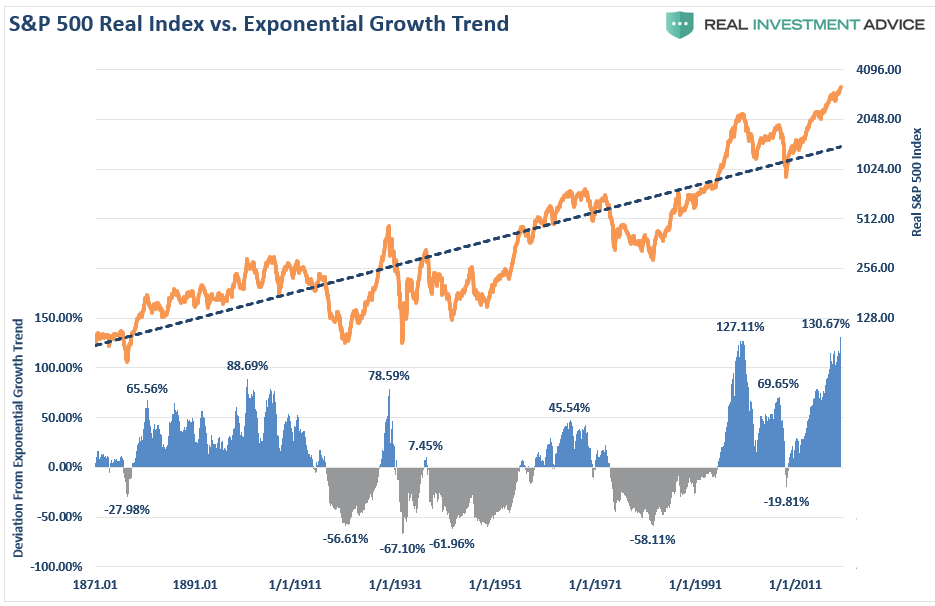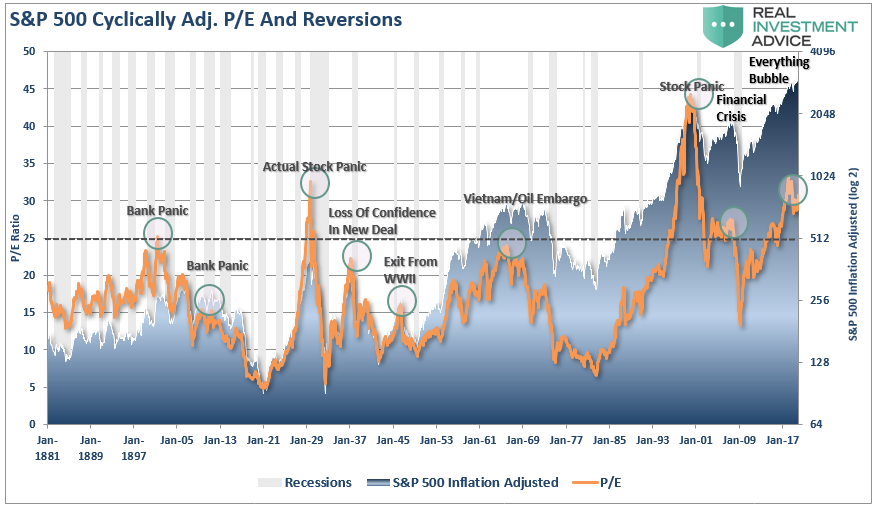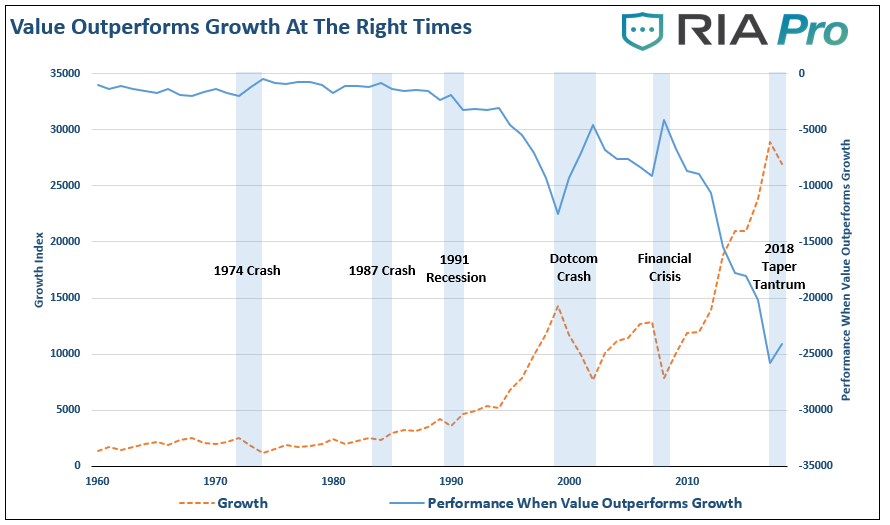by Lance Roberts, RIA Pro
In late 1999, it was stated that “investing like Warren Buffett was the same as driving ‘Dad’s ole’ Pontiac.” The suggestion, of course, was that “value” investing was no longer a viable investment strategy in the new “dot.com” economy where “growth” was all that mattered. After all, in the “new world,” it was indeed “different this time.”
Less than a year later, investors wished they had adhered to Warren Buffett’s strategy of buying value as the “Dot.com dream” emerged as a nightmare for many unwitting individuals.
However, it wasn’t just stocks either. In 2007, individuals were chasing the “momentum” in the real estate market as individuals left their jobs to pursue riches in housing and were willing to “pay any price” under the assumption they would be able to sell higher. Of course, it was long after then Fed Chairman Ben Bernanke uttered the words “the subprime market is contained,” the dreams of riches evaporated like a “morning mist.”
As Warren Buffett once quipped, “price is what you pay, value is what you get.”
Throughout market history, investors have repeatedly abandoned this simple principle during periods where bull market advances seemed to defy logic. Ultimately, those investors paid a dear price for their speculation as the reality of “overpaying for value” led to poor financial outcomes.
As we have noted in a series of articles posted at RIAPRO.net, we believe the market is on the precipice of another monumental shift from “growth” to “value,” and as repeatedly seen in the past will blindside most investors.
Value vs. Growth
The market’s surge higher since the financial crisis, which has been driven by massive fiscal and monetary policies, have been nothing short of extraordinary. Currently, the S&P 500 is trading at the greatest deviation from its long-term exponential growth trend in history.

This is occurring at a time where market prices are advancing while corporate profitability has been flat since 2014.
While we have previously discussed the unparalleled use of monetary policy to push markets higher, massive fiscal spending designed to keep economic growth positive, and how corporations have shunned future growth with a preference for the short-term incentive of “share repurchases.”
As Michael Lebowitz, CFA previously noted:
“As a result of these behaviors and actions, we have witnessed an anomaly in what has historically spelled success for investors. Stronger companies with predictable income generation and solid balance sheets have grossly underperformed companies with unreliable earnings and over-burdened balance sheets. The prospect of majestic future growth has trumped dependable growth. Companies with little to no income and massive debts have been the winners.”
This was much the same as we saw in late 1999 as companies with no earnings, no revenue, and no real strategy for growth exploded higher in a speculation fueled buying frenzy.
This underperformance of “value” relative to “growth” is not unique. What is unique is the current duration and magnitude of that underperformance. To say unprecedented is almost an understatement.
The graph below charts ten-year annualized total returns (dividends included) for value stocks versus growth stocks. The most recent data point representing 2018, covering the years 2009 through 2018, stands at negative 2.86%. This indicates value stocks have underperformed growth stocks by 2.86% on average in each of the last ten years.
The data for this analysis comes from Kenneth French and Dartmouth University.

There are two important takeaways from the graph above:
- Over the last 90 years, value stocks have outperformed growth stocks by an average of 4.44% per year (orange dotted line).
- There have only been eight ten-year periods over the last 90 years (total of 90 ten-year periods) when value stocks underperformed growth stocks. Two of these occurred during the Great Depression and one spanned the 1990s leading into the Tech bust of 2001. The other five are recent, representing the years 2014 through 2018.
It is important to understand that it is “investor speculation” which drives these deviations in returns between growth and value. Of course, when things ultimately go “pear-shaped,” the return to value tends to be a swift event. The chart below overlays important periods in market history where “value” became “valued.”
The chart below shows the difference in the performance of the “value vs growth” index versus a pure growth index. Both are based on a $100 investment. While value investing will always provide consistent returns, there are times when growth outperforms value and vice versa. What is important to note are the periods when “value investing” has the greatest outperformance as noted by the “blue shaded” areas.
Given that we are statistically, and logically, very likely nearing the end of the current cycle, it is even more crucial to grasp what decades of investment experience tells us about the future.
When the cycle turns, we have little doubt the value-growth relationship will revert back to its long-term mean. Importantly, seldom do such reversions stop at the mean.
“To better understand why this is so important, consider what happens if the investment cycle turns and the relationship of value versus growth returns to the average over the next two years. In such a case, value would outperform growth by nearly 30% in just two years. Anything beyond the average would increase the outperformance even more.” – Michael Lebowitz
History Doesn’t Repeat
It is often noted that history doesn’t repeat, but it often rhymes, particularly when it comes to financial markets. It is not a question of if the rotation to value will occur, it is only a function of when.
However, this is the risk that investors take on currently in the market. Chasing markets is the purest form of speculation. Ultimately, it is a pure bet on prices going higher rather than determining if the price being paid for those assets are selling at a discount to fair value.
Benjamin Graham, along with David Dodd, attempted a precise definition of investing and speculation in their seminal work Security Analysis (1934).
“An investment operation is one which, upon thorough analysis, promises safety of principal and a satisfactory return. Operations not meeting these requirements are speculative.”
There is also a very important passage in Graham’s The Intelligent Investor:
“The distinction between investment and speculation in common stocks has always been a useful one, and its disappearance is a cause for concern. We have often said that Wall Street as an institution would be well advised to reinstate this distinction and to emphasize it in all its dealings with the public. Otherwise, the stock exchanges may someday be blamed for heavy speculative losses, which those who suffered them had not been properly warned against.”
While the current market advance seems to be unstoppable, this was the attitude seen by investors at every prior market in history. As Howard Marks once stated:
“Rule No. 1: Most things will prove to be cyclical.
Rule No. 2: Some of the greatest opportunities for gain and loss come when other people forget Rule No. 1.”
The realization that nothing lasts forever is critically important to long term investing. To “buy low,” one must have first “sold high.” Understanding that all things are cyclical suggests that after long price increases, investments become more prone to declines than further advances.
The rotation from “growth” to “value” is inevitable. It will occur against a backdrop of devastation for the majority of investors quietly lulled into the extreme sense of complacency years of monetary interventions have provided.
The only question is whether you will be the buyer of “value” at a time when everyone else is selling “growth?”
Copyright © RIA Pro

















